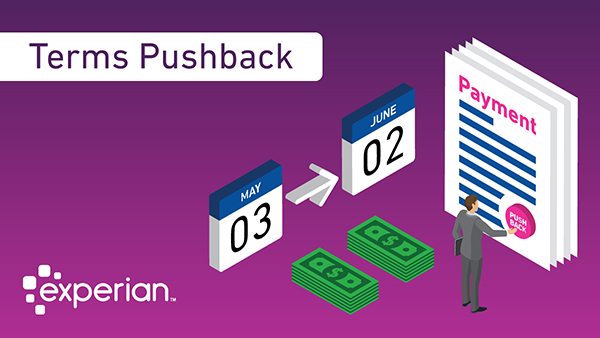
In this week’s guest post, Scott Blakeley shares perspectives on a growing trend in business – Terms Pushback (TPB). Scott is the founder of Blakeley, LLP, a noted expert in the field of creditors’ rights, commercial law, e-commerce and bankruptcy law. Scott regularly speaks to industry groups around the country and via monthly webcasts on the topics of creditors rights and bankruptcy.
After a slow sales quarter, a large retail clothing store needs to improve their working capital and cash flow. Before the 2008 recession, the retailer likely would have turned to traditional business credit options. However, after the downturn, lenders changed their qualifications and terms, making traditional credit options a much less desirable option. In some cases, retailers, especially midsize or new businesses, can no longer even qualify for traditional credit sources.
Businesses are now increasingly renegotiating their payment terms with suppliers through a program called Terms Pushback (TPB). When a jewelry retailer reviews its payment terms, for example, it sees that the main vendor supplier for jewelry currently requires payment 15 days after delivery. As a deliberate strategy — which is different from a company not having the money to pay its bill — to give the retailer more working capital, they reach out to ask the supplier to change the terms to 30 days. This means they would have access to the money paid to the vendor for 15 days longer; this process is often referred to as trade credit. Credit Today found that the most common extension is for 16 to 30 days, with 45% reporting this range as the most common extension.
Impact of Terms Pushback on Suppliers
While TPB improves cash flow for customers, it causes issues for suppliers because they must wait longer for their payment. Many consultants are now actively recommending TPB as a best practice. Because international companies more commonly using this strategy, many U.S.-based companies are adopting it due to international influence.
Companies operating as middlemen between retailers and manufacturers often face the biggest challenges. Longer terms mean that they have less capital to buy more products and have a higher number of outstanding receivables. Additionally, businesses have lower cash conversion metrics, which can hurt publicly traded companies and cause concern for shareholders.
According to Credit Today Bench-marking, 19% of suppliers always or usually say no to requests for extended terms, and 3% usually agree. Interestingly, 4% report that their answer depends on customer size — yes to large customers and no to small customers. However, the majority (63%) of businesses review the requests on their individual merits.
However, denying the request often has long-term ramifications. If the business denies the request, the customer must pay or suffer credit damage. Customers often get around this by paying late enough to improve their own cash flow but before credit damage occurs. Even more challenging, suppliers are often hesitant to report customers to credit bureaus because this often permanently damages or even ends the relationship.
If a supplier denies the request, the majority of options to get the payment are punitive. For example, the supplier can charge a late fee for payment. However, the customer may still decide that the value of the money for the extra days is worth more than the late fee. Other avenues include implementing a credit hold, having two price lists, terminating credit, firing the customer and reporting the customer to industry groups. However, each of these options permanently damages and probably ends the customer relationship, which may result in loss of a high volume of sales.
Effectively Managing Terms Pushback with Supply Chain Finance Programs
Supply Chain Finance programs are asset-based lending programs structured to improve a customer’s payment terms, reduce costs and improve cash flow enabling financial institutions to pay suppliers for invoiced services. Suppliers can benefit from SCFP as it receives payment within normal terms or earlier which helps keep the credit team’s credit scoring and risk models consistent. The customers benefits as well as their capital is not tied up in day-to-day operational payments and creates more reinvestment opportunities.
When a company receives a TPB request, the first step is evaluating the customer — their credit, the risk, the volume of business and the value of the relationship for the supplier. Often, larger companies have an advantage over smaller companies when negotiating term extensions because their business relationship is worth more to the customer than the monetary value of the shorter term.
Here are three best practices to managing TPB requests:
- Offer incentives for shorter terms. Instead of punitive actions, consider giving customers who pay within shorter terms a discount or an annual volume discount for consistent payment with shorter terms.
- Actively monitor threshold for customers with extended terms. Suppliers must effectively manage their own cash flow to make payroll and other expenses. By extending too many customer terms, suppliers can jeopardize their own financial stability.
- Create a team to evaluate requests. By establishing a process to handle the requests and a team to formally evaluate requests, suppliers can more effectively evaluate all aspects of the decision, such as the risks of extending to its own financial health and the risk of losing the client relationship. With a team made representing stakeholders from different departments, all perspectives can be represented and considered.
As TPB becomes more common as a strategy, suppliers must proactively create a process to manage requests. Often, extending the terms can improve the customer relationship and even increase the amount ultimately paid. By creating a team and strategy, suppliers can make the smartest decision and actively manage pushback requests.
 Scott Blakeley is a founder of Blakeley LLP, where he advises companies around the United States and Canada regarding creditors’ rights, commercial law, e-commerce and bankruptcy law. He was selected as one of the 50 most influential people in commercial credit by Credit Today. He is contributing editor for NACM’s Credit Manual of Commercial Law, contributing editor for American Bankruptcy Institute’s Manual of Reclamation Laws, and author of A History of Bankruptcy Preference Law, published by ABI. Credit Research Foundation has published his manuals entitled The Credit Professional’s Guide to Bankruptcy, Serving On A Creditors’ Committee and Commencing An Involuntary Bankruptcy Petition. Scott has published dozens of articles and manuals in the area of creditors’ rights, commercial law, e-commerce and bankruptcy in such publications as Business Credit, Managing Credit, Receivables & Collections, Norton’s Bankruptcy Review and the Practicing Law Institute, and speaks frequently to credit industry groups regarding these topics throughout the country. He is a member on the board of editors for the California Bankruptcy Journal, and is co-chair of the sub-committee of unsecured creditors’ Committee of the ABI. Scott holds an B.S. from Pepperdine University, an M.B.A. from Loyola University and a law degree from Southwestern University. He served as law clerk to Bankruptcy Judge John J. Wilson. He is admitted to the Bar of California.
Scott Blakeley is a founder of Blakeley LLP, where he advises companies around the United States and Canada regarding creditors’ rights, commercial law, e-commerce and bankruptcy law. He was selected as one of the 50 most influential people in commercial credit by Credit Today. He is contributing editor for NACM’s Credit Manual of Commercial Law, contributing editor for American Bankruptcy Institute’s Manual of Reclamation Laws, and author of A History of Bankruptcy Preference Law, published by ABI. Credit Research Foundation has published his manuals entitled The Credit Professional’s Guide to Bankruptcy, Serving On A Creditors’ Committee and Commencing An Involuntary Bankruptcy Petition. Scott has published dozens of articles and manuals in the area of creditors’ rights, commercial law, e-commerce and bankruptcy in such publications as Business Credit, Managing Credit, Receivables & Collections, Norton’s Bankruptcy Review and the Practicing Law Institute, and speaks frequently to credit industry groups regarding these topics throughout the country. He is a member on the board of editors for the California Bankruptcy Journal, and is co-chair of the sub-committee of unsecured creditors’ Committee of the ABI. Scott holds an B.S. from Pepperdine University, an M.B.A. from Loyola University and a law degree from Southwestern University. He served as law clerk to Bankruptcy Judge John J. Wilson. He is admitted to the Bar of California.

